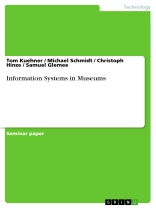Seminar paper from the year 2003 in the subject Engineering – Industrial Engineering and Management, grade: 1, 0 (A), Linköping University (Institute for technology), course: Information Systems, language: English, abstract: In almost every part of modern life we have contact with different information systems. In the last few decades the computer became a more and more important medium for collecting, structuring and providing of information. A relative new invention is the possibility to locate a certain device in the physical space. It was originally developed for military purposes, but comes now to a broader application in the private and public sector. As a rather specific but never the less significant example we would like to present a connection of computing in one of its latest appearances and the possibility of locating devices connected to a totally new kind of information system. We would like to introduce the use of handheld computers for the use of a push/pull information system in the context of an exhibition or museum. Automation technologies were introduced to museums in the early 1960s. Projects like SELGEM (Self Generating Master) involved several museums and supported data entry to track collection information. Large scale computer use by museums was not feasible at that time because early computers were expensive and required space for installation. But that would change quickly. In 1968 Hewlett-Packard released its first programmable calculators. The early machines, such as the HP-9100, weighed 40 pounds and might be considered the first desktop computers. While Texas Instruments is credited with inventing the first pocket calculator in 1967, Hewlett-Packard developed the first programmable pocket calculator in 1974. After a NASA mission, the pocket HP-65 was promoted as having served ‘as a backup for Apollo’s on-board computer.’ In ten years programmable computers had evolved from filling rooms to fitting in pockets.
While pocket computers may have found immediate use in museum offices, evidence of pocket computers enhancing the visitor experience was not found. The use of hand helds in museum exhibitions seems to have been inspired by the early personal digital assistants (PDAs) such as the Zaurus, Psion, and Newton. In 1993 two young men formed a company, Visible Interactive, around their modification of the Apple Newton they called i Go. Promoting it as the “world’s first interactive audio tour” their idea was to provide museum visitors with an enhanced personal experience through the accessibility of multimedia, text, and audio while walking through an exhibit space. […]
Tom Kuehner & Michael Schmidt
Information Systems in Museums [EPUB ebook]
Information Systems in Museums [EPUB ebook]
购买此电子书可免费获赠一本!
语言 英语 ● 格式 EPUB ● 网页 21 ● ISBN 9783638224932 ● 文件大小 0.6 MB ● 出版者 GRIN Verlag ● 市 München ● 国家 DE ● 发布时间 2003 ● 版 1 ● 下载 24 个月 ● 货币 EUR ● ID 3658074 ● 复制保护 无












